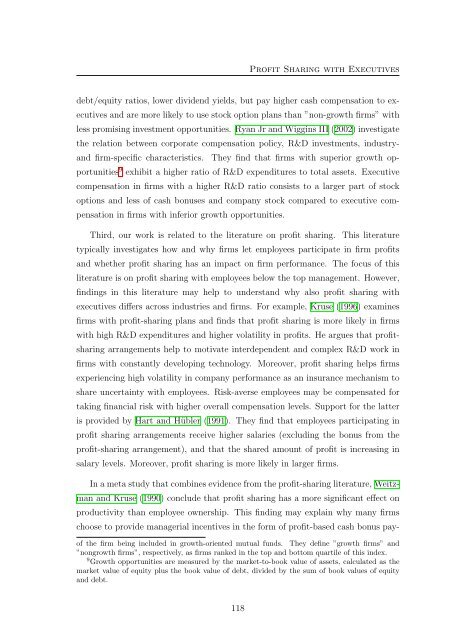Three Essays on Executive Compensation - KOPS - Universität ...
Three Essays on Executive Compensation - KOPS - Universität ...
Three Essays on Executive Compensation - KOPS - Universität ...
Create successful ePaper yourself
Turn your PDF publications into a flip-book with our unique Google optimized e-Paper software.
Profit Sharing with <strong>Executive</strong>s<br />
debt/equity ratios, lower dividend yields, but pay higher cash compensati<strong>on</strong> to executives<br />
and are more likely to use stock opti<strong>on</strong> plans than ”n<strong>on</strong>-growth firms” with<br />
less promising investment opportunities. Ryan Jr and Wiggins III (2002) investigate<br />
the relati<strong>on</strong> between corporate compensati<strong>on</strong> policy, R&D investments, industryand<br />
firm-specific characteristics.<br />
They find that firms with superior growth opportunities<br />
9 exhibit a higher ratio of R&D expenditures to total assets. <strong>Executive</strong><br />
compensati<strong>on</strong> in firms with a higher R&D ratio c<strong>on</strong>sists to a larger part of stock<br />
opti<strong>on</strong>s and less of cash b<strong>on</strong>uses and company stock compared to executive compensati<strong>on</strong><br />
in firms with inferior growth opportunities.<br />
Third, our work is related to the literature <strong>on</strong> profit sharing. This literature<br />
typically investigates how and why firms let employees participate in firm profits<br />
and whether profit sharing has an impact <strong>on</strong> firm performance. The focus of this<br />
literature is <strong>on</strong> profit sharing with employees below the top management. However,<br />
findings in this literature may help to understand why also profit sharing with<br />
executives differs across industries and firms. For example, Kruse (1996) examines<br />
firms with profit-sharing plans and finds that profit sharing is more likely in firms<br />
with high R&D expenditures and higher volatility in profits. He argues that profitsharing<br />
arrangements help to motivate interdependent and complex R&D work in<br />
firms with c<strong>on</strong>stantly developing technology. Moreover, profit sharing helps firms<br />
experiencing high volatility in company performance as an insurance mechanism to<br />
share uncertainty with employees. Risk-averse employees may be compensated for<br />
taking financial risk with higher overall compensati<strong>on</strong> levels. Support for the latter<br />
is provided by Hart and Hübler (1991). They find that employees participating in<br />
profit sharing arrangements receive higher salaries (excluding the b<strong>on</strong>us from the<br />
profit-sharing arrangement), and that the shared amount of profit is increasing in<br />
salary levels. Moreover, profit sharing is more likely in larger firms.<br />
In a meta study that combines evidence from the profit-sharing literature, Weitzman<br />
and Kruse (1990) c<strong>on</strong>clude that profit sharing has a more significant effect <strong>on</strong><br />
productivity than employee ownership. This finding may explain why many firms<br />
choose to provide managerial incentives in the form of profit-based cash b<strong>on</strong>us payof<br />
the firm being included in growth-oriented mutual funds. They define ”growth firms” and<br />
”n<strong>on</strong>growth firms”, respectively, as firms ranked in the top and bottom quartile of this index.<br />
9 Growth opportunities are measured by the market-to-book value of assets, calculated as the<br />
market value of equity plus the book value of debt, divided by the sum of book values of equity<br />
and debt.<br />
118
















